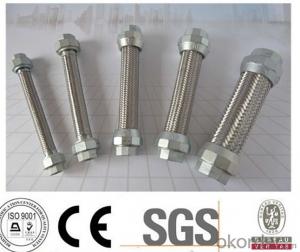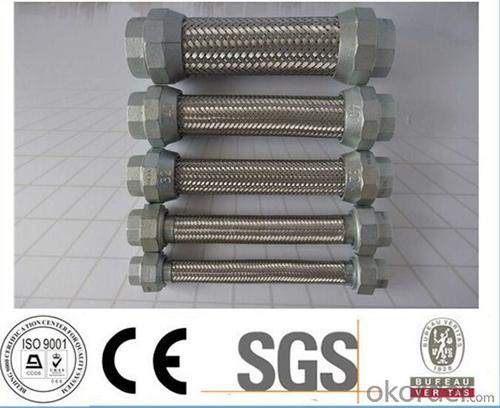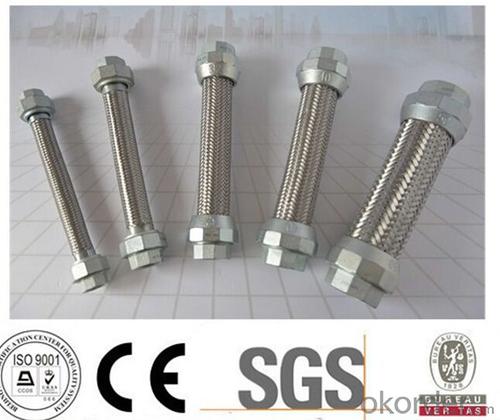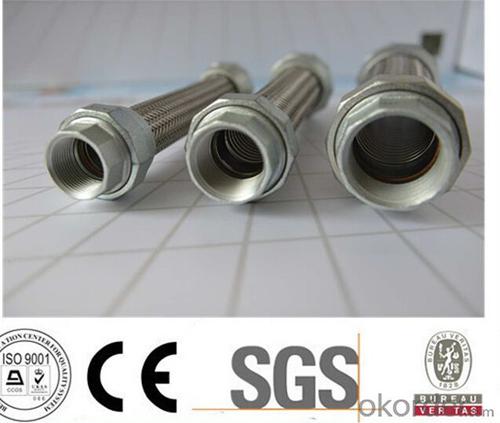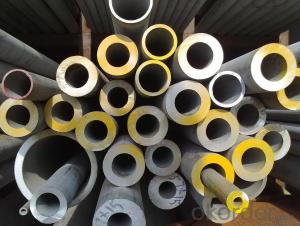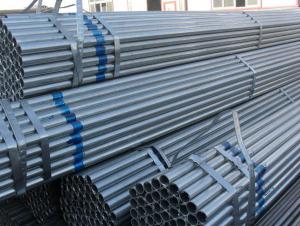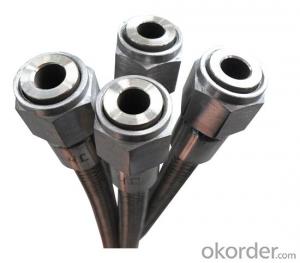Stainless Steel Braid Hose with Flexible Surface
- Loading Port:
- Tianjin
- Payment Terms:
- TT OR LC
- Min Order Qty:
- 10000 pc
- Supply Capability:
- 100000 pc/month
OKorder Service Pledge
OKorder Financial Service
You Might Also Like
Specification
Stainless Steel Braid Hose with Flexible Surface
Applications of Stainless Steel Braid Hose with Flexible Surface:
--Refueling system
--Chemical and pharmaceutical industry
--Industrial hydraulic systems
--Air conditioners in industrial and construction –site vehicles
--Food and beverage industry
--Special and standard industrial applications
--Water and cleaning management
Features of Stainless Steel Braid Hose with Flexible Surface:
1. )O. D.: 13-18MM 0.2-3M long
2. )Nut.: Nickel/Chrome Plated Brass (Zinc / Iron / Aluminum is available)
3. )Size Of Nut.: Female&Male 1/2''; 3/4''; 3/8''; 7/8''; 5/16'', and M10...
4. )Insert.: Brass (Zinc / Aluminum / Plastic is available)
5. )Inner tube.: Rubber/ EPDM/PVC
6. )Covered Material: Stainless Steel 201, 301, 304 /Aluminium Wire
7. )Working Pressure: 5Kg-15Kg
8. )Temperature: 0-92° C
9. )Quality Assurance: 3 years
RemarkAPPLICATION: HOUSEEHOLD WARE, BATHROOM WARE, SHOWER HOSE
PAYMENT: T/T, L/C
DELIVERY TIME: 20DAYS OR 30DAYS AFTER RECEIVED 30% DEPOSITS
MOQ: 5000PCS
ODM&OEM IS ACCEPTABLE
PackageInner: PP bag /Blister packing Outer: Carton box
Specifications of Stainless Steel Braid Hose with Flexible Surface:
NO | I.D | Refer to O.D | Working pressure | Burst pressure | approximate Weight | |||||
(inch) | (mm) | (inch) | (mm) | MPa | Psi | MPa | Psi | kg/m | lbs/ft | |
1 | 1/8 | 3.2±0.2 | 0.35 | 9±0.3 | 2.06 | 300 | 8.27 | 1200 | 0.078 | 0.12 |
2 | 5/32 | 4±0.2 | 0.4 | 10±0.3 | 2.06 | 300 | 8.27 | 1200 | 0.092 | 0.14 |
3 | 3/16 | 4.8±0.2 | 0.43 | 11±0.3 | 2.06 | 300 | 8.27 | 1200 | 0.108 | 0.16 |
4 | 1/4 | 6.3±0.3 | 0.5 | 12.7±0.3 | 2.06 | 300 | 8.27 | 1200 | 0.134 | 0.2 |
5 | 5/16 | 8.0±0.3 | 0.56 | 14±0.3 | 2.06 | 300 | 8.27 | 1200 | 0.147 | 0.22 |
6 | 3/8 | 9.5±0.3 | 0.63 | 16±0.4 | 2.06 | 300 | 8.27 | 1200 | 0.182 | 0.27 |
7 | 15/32 | 12±0.3 | 0.75 | 19±0.5 | 2.06 | 300 | 8.27 | 1200 | 0.238 | 0.35 |
8 | 1/2 | 12.7±0.4 | 0.78 | 20±0.5 | 2.06 | 300 | 8.27 | 1200 | 0.262 | 0.39 |
9 | 5/8 | 16±0.4 | 0.94 | 24±0.5 | 1.03 | 150 | 4.12 | 600 | 0.351 | 0.52 |
10 | 3/4 | 19±0.4 | 1.13 | 28.8±0.5 | 1.03 | 150 | 4.12 | 600 | 0.515 | 0.77 |
11 | 1 | 25.4±0.5 | 1.38 | 35±0.6 | 1.03 | 150 | 4.12 | 600 | 0.637 | 0.95 |
Images of Stainless Steel Braid Hose with Flexible Surface:
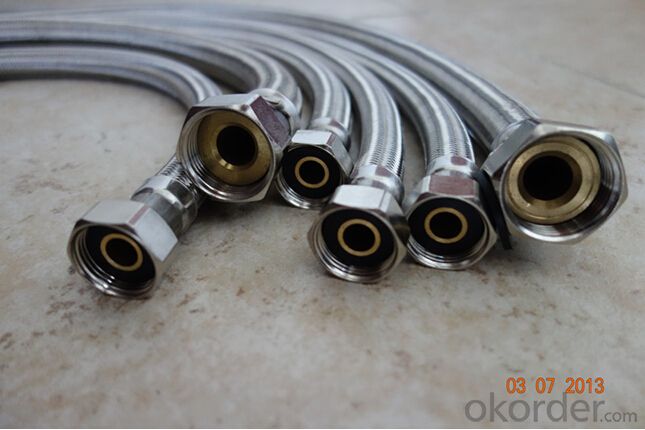
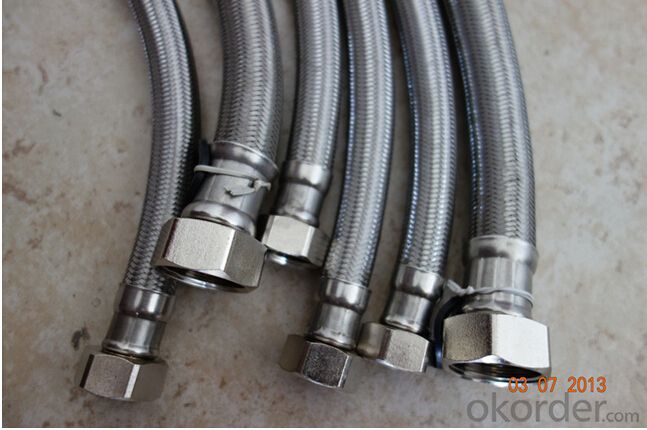
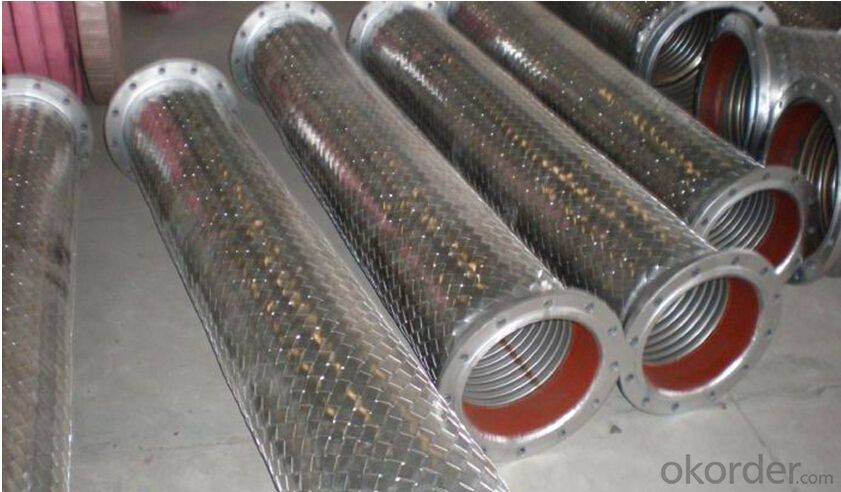
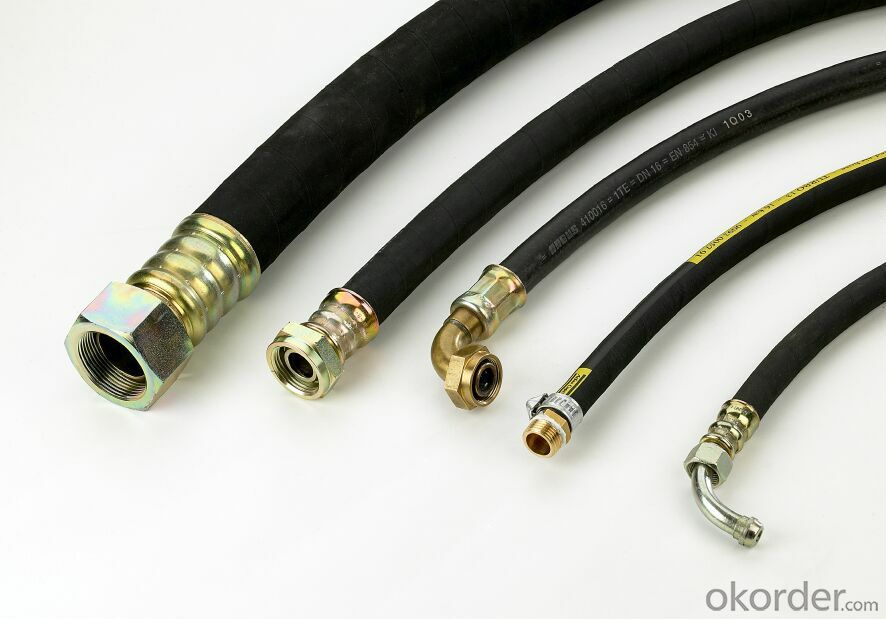
Package of Stainless Steel Braid Hose with Flexible Surface:
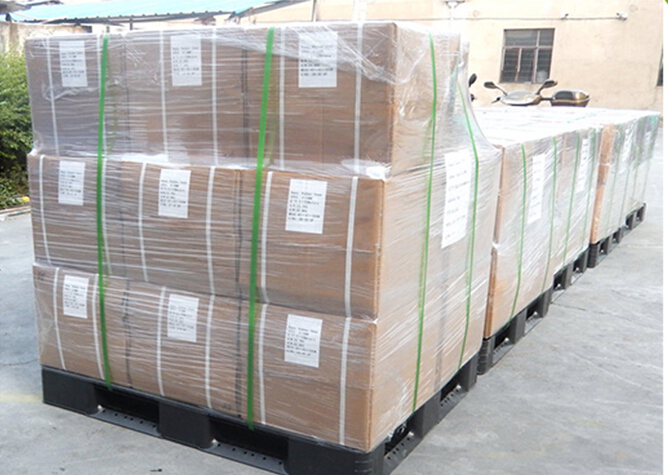
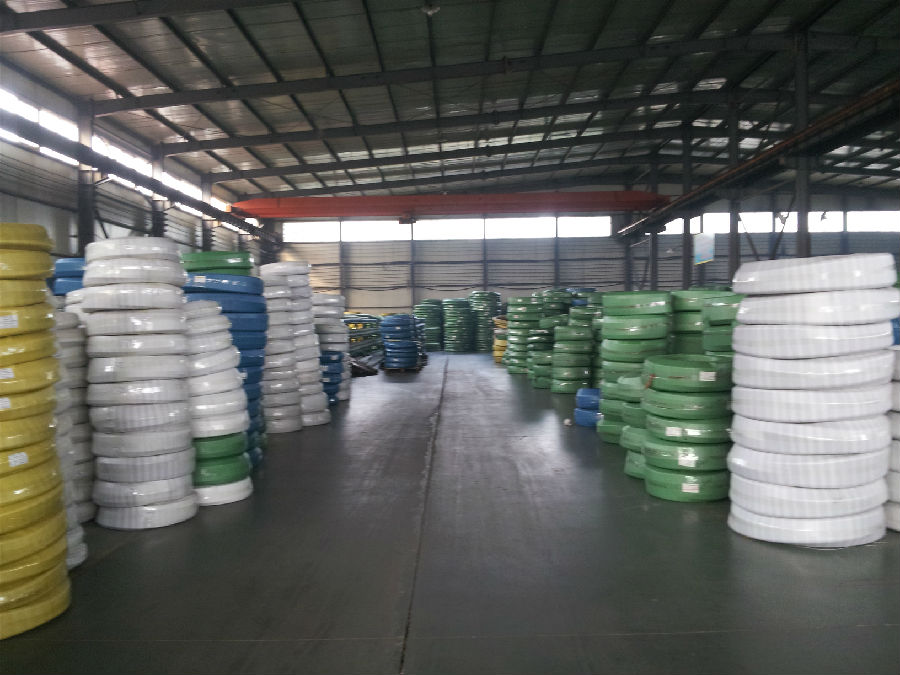
FAQ of Stainless Steel Braid Hose with Flexible Surface:
Who we are:
Answer: We CNBM is a Chinese state-owned enterprise ranked 267th among the Global Fortune 500, as the largest building materials company,we have over 300 affiliated companies,and so many production lines and branch office distribute in China.
2. About our quality:
Answer: Every product needs to be quality proved before shipping.
3. About our service:
Answer: We could gurantte that we can reply you in 2 working hours.
- Q: Can stainless steel pipes be inspected for defects?
- Stainless steel pipes indeed undergo inspections to detect defects. Numerous methods and techniques exist for this purpose. A widely employed approach involves visual inspection, wherein well-trained inspectors visually examine the pipes' exterior surface to spot visible defects like cracks, corrosion, or dents. Apart from visual inspection, non-destructive testing (NDT) methods also prove useful for inspecting stainless steel pipes. NDT techniques like ultrasonic testing, radiographic testing, magnetic particle testing, and dye penetrant testing effectively identify internal defects such as cracks, weld flaws, or any other discontinuities that might jeopardize the pipe's integrity. These inspection methods guarantee that stainless steel pipes meet the necessary quality standards and specifications. By promptly detecting defects, appropriate actions can be taken to rectify or replace faulty pipes, thus ensuring a secure and reliable performance in various applications like plumbing, oil and gas pipelines, and industrial processes.
- Q: What is the difference between 304H and 304L stainless steel pipes?
- The main difference between 304H and 304L stainless steel pipes lies in their carbon content. 304H stainless steel pipes have a higher carbon content, typically around 0.04-0.10%, which makes them suitable for high-temperature applications. This higher carbon content provides improved high-temperature strength and resistance to sensitization, which is the formation of chromium carbides at grain boundaries, leading to reduced corrosion resistance. On the other hand, 304L stainless steel pipes have a lower carbon content, usually around 0.03%, which makes them more suitable for welding applications. The lower carbon content helps to minimize the formation of chromium carbides, thus reducing the risk of sensitization during welding. This results in improved corrosion resistance and enhanced weldability. In summary, while both 304H and 304L stainless steel pipes are variants of the 304 grade, the difference lies in their carbon content. 304H pipes are preferred for high-temperature applications due to their higher carbon content and improved high-temperature strength, while 304L pipes are more suitable for welding applications due to their lower carbon content and enhanced weldability.
- Q: What is the difference between 904L and 2205 stainless steel pipes?
- 904L and 2205 are both types of stainless steel pipes, but they have some key differences. Firstly, the composition of the two steels is different. 904L stainless steel is a high alloy austenitic stainless steel that contains high levels of chromium, nickel, and molybdenum. It also has low carbon content, making it highly resistant to corrosion and pitting. On the other hand, 2205 stainless steel is a duplex stainless steel that consists of a mixture of austenite and ferrite phases. It contains lower levels of chromium and nickel compared to 904L, but has higher levels of molybdenum and nitrogen. Secondly, the mechanical properties of the two steels differ. 904L stainless steel has excellent toughness and high strength, making it suitable for applications in aggressive environments such as chemical processing plants and offshore oil and gas platforms. In contrast, 2205 stainless steel has good overall mechanical properties, with high tensile and yield strength. It is commonly used in industries such as marine, paper, and pulp, where resistance to stress corrosion cracking is important. Another difference lies in their resistance to corrosion. While both steels are corrosion-resistant, 904L stainless steel has exceptional resistance to a wide range of corrosive environments, including sulfuric acid, hydrochloric acid, and saltwater. This makes it ideal for use in industries where extreme corrosion resistance is required. 2205 stainless steel, although not as corrosion-resistant as 904L, still offers good resistance to many corrosive substances, making it suitable for various applications. Cost is another factor that sets these steels apart. Due to its high alloy content and superior properties, 904L stainless steel is generally more expensive than 2205 stainless steel. Therefore, the choice between the two will depend on the specific requirements of the application and the budget. In summary, the main differences between 904L and 2205 stainless steel pipes lie in their composition, mechanical properties, corrosion resistance, and cost. Understanding these distinctions will help in selecting the appropriate stainless steel pipe for a given application.
- Q: Are stainless steel pipes fire-resistant?
- Indeed, fire resistance is a characteristic possessed by stainless steel pipes. Renowned for its elevated melting point and exceptional fire resistance, stainless steel is a secure material choice for numerous purposes, including the construction of pipes. With its incapability to readily ignite or facilitate the expansion of flames, stainless steel ensures safety in various applications. Moreover, stainless steel pipes exhibit remarkable durability and strength even when exposed to high temperatures, assuring an additional layer of safety in environments susceptible to fires.
- Q: Can stainless steel pipes be insulated with polyvinylidene fluoride?
- Yes, stainless steel pipes can be insulated with polyvinylidene fluoride (PVDF). PVDF is a high-performance fluoropolymer that offers excellent thermal and chemical resistance properties, making it suitable for insulating stainless steel pipes in various industrial applications.
- Q: Stainless steel pipe drilling?
- General requirements for processing stainless steel workpiece hole smooth, less burr, white technology generally choose high-quality grinding drill, on the market are mostly black rolling process, the main difference between full grinding and rolling process is drilling with the drill chuck supporting the overall use of small amplitude and hole grinding, less burr, the accuracy is high especially, when batch processing efficiency.
- Q: What is the difference between Schedule 10 and Schedule 40 stainless steel pipes?
- The main difference between Schedule 10 and Schedule 40 stainless steel pipes lies in their wall thickness. Schedule 10 pipes have a thinner wall thickness, making them lighter and more economical, suitable for low-pressure applications. On the other hand, Schedule 40 pipes have a thicker wall, providing higher strength and durability, making them suitable for high-pressure applications.
- Q: Can stainless steel pipes be insulated with polybutylene?
- No, stainless steel pipes cannot be insulated with polybutylene. Polybutylene is a type of plastic material that is commonly used as a water supply pipe. It is not suitable for insulating stainless steel pipes. Stainless steel pipes are already highly resistant to corrosion and do not require additional insulation for thermal purposes. If insulation is needed for stainless steel pipes, other materials such as fiberglass or foam pipe insulation can be used.
- Q: Are stainless steel pipes suitable for underground sewage systems?
- Yes, stainless steel pipes are suitable for underground sewage systems. They have excellent corrosion resistance, durability, and strength, which make them highly reliable for handling sewage and wastewater in underground applications.
- Q: Are stainless steel tubes and galvanized steel tubes the same?
- Stainless steel management theory, the whole is not rusty, from the table to the material is stainless steel, no surface and internal.
Send your message to us
Stainless Steel Braid Hose with Flexible Surface
- Loading Port:
- Tianjin
- Payment Terms:
- TT OR LC
- Min Order Qty:
- 10000 pc
- Supply Capability:
- 100000 pc/month
OKorder Service Pledge
OKorder Financial Service
Similar products
Hot products
Hot Searches
Related keywords

